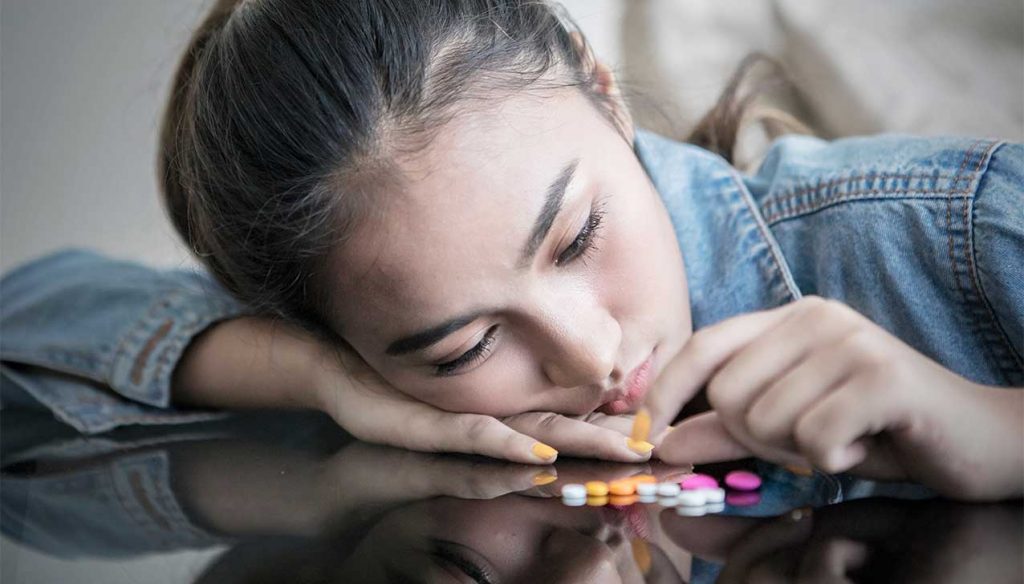Teenagers turn to drugs for a variety of reasons, including curiosity, peer pressure, and mental health issues.
No matter the reason, teen substance use can seriously hinder your child’s brain development. It may also lead to substance use disorder (drug addiction) and other health problems.
Here’s what all parents should know about teen drug use and how to prevent it.
Teen Drug Use Statistics
According to the Centers for Disease Control and Prevention (CDC), the most commonly used drugs among teenagers are marijuana, nicotine, and alcohol.
About half of high school students have used marijuana, and about 4 in 10 have smoked cigarettes. By the end of high school, about two-thirds of students have used alcohol.
Also, in recent years, many teens have started vaping (using electronic cigarettes).
This practice poses serious health risks, including brain damage, heart problems, and lung cancer. According to the CDC, over 2 million middle and high school students in the United States reported vaping in 2021.
Overall Decline
Overall, teenage drug use has significantly declined in the past year. Every year, the National Institute on Drug Abuse (NIDA) funds Monitoring the Future (MTF), a national survey that measures adolescent drug use.
The 2021 survey found the largest decline in teen illicit drug use in 46 years.
Specifically, the number of teens who had used illicit drugs besides marijuana (such as heroin and methamphetamine) fell by more than 25% compared to the previous year. The survey also showed declines in many other types of teen drug use, including marijuana use, nicotine use, alcohol use, and prescription opioid use.
Researchers link these declines to the COVID-19 pandemic. Due to lockdowns and social distancing, teens have had more parental supervision, less access to drugs, and less access to peers who encourage drug use.
However, as pandemic-related restrictions ease, all parents should know how to identify, treat, and prevent teen drug use.
Signs Of Teen Drug Use
In most cases, a teen who uses drugs will display physical, psychological, and social warning signs.
Physical Signs
The most common physical signs of teen drug use include:
- bloodshot eyes
- change in pupil size
- sudden decline in hygiene
- unusual smells on breath or clothes
- sudden change in eating and/or sleeping habits
- sudden change in weight
- frequent sniffling or runny nose
- slurred speech
- shaking
- unexplained burns, bruises, or other injuries
You may also find drug paraphernalia in your child’s room, car, or other personal space. These items may include pipes, bongs, needles, syringes, tinfoil, burnt spoons, rolled up dollar bills, or razor blades.
Psychological Signs
The most common physical signs of teen drug use include:
- extreme mood swings
- anxiety
- irritability
- periods of increased energy and talkativeness
- loss of motivation
Social Signs
The most common social signs of teen drug use include:
- sudden change in friends
- loss of interest in activities once enjoyed
- unexplained absences
- poor grades
- secretive or suspicious behaviors, such as frequently borrowing money
If you notice these signs, talk to your child. Explain that you’re concerned about their behavior. Be patient and understanding, and don’t accuse your child of anything.
The above behaviors don’t always indicate a drug problem. They could also signal other emotional or mental health issues, such as stress, depression, bipolar disorder, or attention-deficit/hyperactivity disorder (ADHD).
If your child admits to using drugs, explain why that behavior is not allowed. Establish clear rules and consequences surrounding drug use.
If your child does not admit to using drugs but their behavior still concerns you, talk to a doctor, behavioral health professional, or substance abuse specialist.
How To Prevent Teen Drug Use
As a parent, you can take these steps to reduce your child’s risk of drug abuse:
Stay Involved In Your Child’s Life
Young people who feel isolated from their families face an increased risk of substance abuse and addiction. That’s why it’s important to spend time with your child and let them know they can talk to you about anything.
Make time for open, honest discussions about mental health, relationships, and other important topics.
Keep Track Of Drugs In Your Home
The first place many teens experiment with drugs is at home. Store alcohol in locked cabinets or other containers, and hide all inhalants (such as glue, paint thinner, aerosol sprays, and whipped cream dispensers).
In addition, keep a log of all over-the-counter and prescription drugs so you’ll know if any pills go missing.
Model Healthy Behavior
Teens with a family history of drug abuse are more likely to abuse drugs themselves. Even if you struggled with drugs in the past, you can prevent your child from doing the same by adopting healthier behaviors today.
Avoid all illegal drugs, and only use prescription drugs as prescribed by a doctor.
Also, if you choose to drink alcohol, do so in moderation. The National Institute on Alcohol Abuse and Alcoholism (NIAAA) defines moderate drinking as no more than one drink a day for women and no more than two drinks a day for men.
If you think your teen may be struggling with substance abuse, please contact Northeast Addictions Treatment Center. Our board-certified healthcare providers offer personalized, evidence-based care to help your child stay drug-free.
Keep Reading
Sources:
Centers for Disease Control and Prevention — Teen Substance Use & Risks
Centers for Disease Control and Prevention — Youth E-Cigarette Use Remains Serious Public Health Concern Amid COVID-19 Pandemic
National Institute on Alcohol Abuse and Alcoholism — Drinking Levels Defined
National Institutes of Health — Percentage of adolescents reporting drug use decreased significantly in 2021 as the COVID-19 pandemic endured


